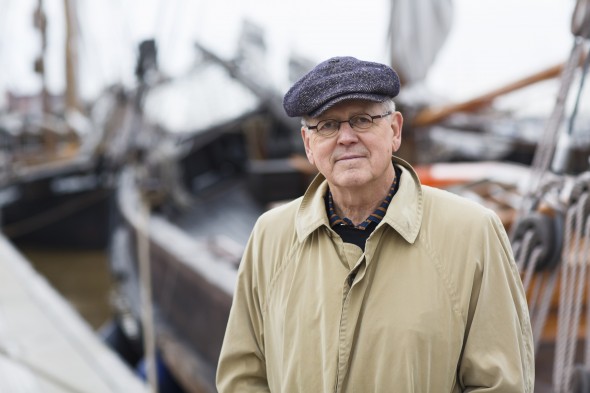Pekka Tarkka on Antti Tuuri
Issue 2/1981 | Archives online, Authors

Antti Tuuri. Photo: Jouni Harala
A character in one of Antti Tuuri’s short stories, a German engineer, remarks: “It has always seemed to me that the Finnish language doesn’t contain individual words – it is just an effusion from a state of mind.” The quotation is taken out of context but it serves as a good description of the slow and sentimental or atmospheric tradition of prose style developed by a number of Finnish writers. This is a category which does not include Antti Tuuri (born 1944). His prose is crisp, clear and concrete in the Indo-European manner. It is not in the least ‘an effusion from a state of mind.’ He uses ‘individual words’ precisely, concrete observations, descriptions of specific phenomena; it is not rare to find numerals in his text.
Tuuri’s style undoubtedly owes something to his training and background. He qualified as an engineer and has worked in a number of posts requiring a high level of technical skill and business ability: he was technical supervisor in a newsprint works and in a wallpaper factory, he has sold Finnish printing equipment abroad and has trained engineers in his field. When Tuuri became Chairman of the Union of Finnish Writers in 1980 he brought to the Union’s administration the modern and professional management techniques that are characteristic of his approach.
Antti Tuuri’s earliest works, two collections of short stories and two novels, were published between 1971 and 1973. Even at this stage his rather flat and unembellished narrative encased something else, a cautious metaphysical statement on the pain and futility of life – there is Angst under the surface, but it is mixed with comic elements. The action often takes place in an impersonal industrial milieu. The behaviouristic aridity of Tuuri’s style can be interpreted as an ironic or critical statement: his characters are shown as disparate or isolated elements in a deterministic social order. His use of language itself was designed to reveal the reification of their world.
By 1975, when Tuuri published a collection of short stories entitled Vuosi elämästä (‘A year of life’), his narrative technique had become richer. The central themes in this collection are the development of youth through experience and the conflict of rationalism and irrationalism; his characters form their view of the world empirically, by trial and error.
Tuuri’s major achivement of this period was the novel Joki virtaa läpi kaupungin (‘A river flows through the town’, 1977). It is the story of three people living in a northern city: a foreman who breaks loose from the twin traps of modern technology and bureaucracy, a fragile artist and an elderly university teacher who rebels against society’s institutionalized attempts to pad life with comforts; he wishes to face death without the benefit of hospital pain-killers and techniques for artificially prolonging life.
A new collection of short stories, Maailman kivisin paikka (‘The stoniest place in the world’) appeared in 1980. The characters are typical of Tuuri: encompassed by loneliness and suffering, they are fighters; it is their passion and, ultimately, their wisdom that enables them to delineate their own destiny and to understand life and death according to the true laws of nature. Tuuri uses the old conventions of the short story, the narrator and the frame. In the longest story that gives the collection its title, the action takes place in an adventurous setting, on the treacherous high seas. There are three narrators, entertaining each other on a sea voyage. We hear grotesque stories about Finnish drunkards, about shipwrecks, about adultery. The scene is dominated, however, by the eldest of the three. He is both enigmatic and wise; his stories, delivered in sentences with the aura of an oracle, seem to the youngest man, stumbling through life, to provide the answers he has been seeking. Tuuri’s tight construction leaves little scope for the vagaries of surprise and chance.
However, he avoids torpor by his use of anecdote, which allows him to shift the range of moods quickly from comedy to tragedy, and by rapid changes of stills, focusing on the multiplicity of human endeavour, often in a rather cruel light.
One of the stories in the 1980 collection is entitled ‘The crucifixion of Mathias Grunewald’. It is the tale of a man who has lost his love. He goes on a somewhat pointless pilgrimage and stays to look at Grunewald’s reredos: the man’s sufferings are unfolded and juxtaposed with the story of Christ’s Agony. Again, dealing with similar themes in ‘The engineer’s story’, which is printed here, Tuuri establishes an external frame to contain his tale. The story is told to two women: we learn about an old friend, his suicide, the vapidness of the aftermath. The terse comments of the ‘listeners’ efficiently translate the story into a serious exploration of the complexity and apparently systematic abrasiveness of life.
Translated by Mary Lomas
No comments for this entry yet
Leave a comment
Also by Pekka Tarkka
Tellervo Krogerus: Sanottu. Tehty. Matti Kuusen elämä 1914–1998. [Said. Done. The life of Matti Kuusi, 1914–1998] - 22 May 2014
In good company - 18 October 2013
Nationalism in war and peace - 3 May 2012
In memoriam Bo Carpelan 1926–2011 - 24 February 2011
Arne Nevanlinna: Hjalmar - 5 November 2010
-
About the writer
Pekka Tarkka (born 1934) is an author and literary critic. Among his works are an extensive biography of the poet and writer Pentti Saarikoski (1937–1983) and of the author Joel Lehtonen (1881–1934; first volume, 2009; the second volume, 2012).
© Writers and translators. Anyone wishing to make use of material published on this website should apply to the Editors.
